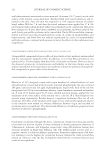DISINFECTION OF REUSABLE MAKE-UP APPLICATORS 171 REFERENCES (1) S. Naz, M. Iqtedar, Q. ul A i n, and K. Afta, Incidence of human skin pathogens from cosmetic tools used in beauty saloons from different areas of lahore, J. Sci. Res., 4(2), 523–527 (2012). (2) H. Dao, P. Lakhani, A. Poli c e, V. Kallakunta, S. S. Ajjarapu, K. W. Wu, P. Ponkshe, M. A. Repka, and S. Narasimha Murthy, Microbial stability of pharmaceutical and cosmetic products, AAPS PharmSci- Tech, 19(1), 60–78 (2018). (3) L. A. Wilson, A. J. Julian, and D. G. Ahearn, The survival and growth of microorganisms in mascara during use, Am. J. Ophthalmol., 79(4), 596–601 (1975). (4) A. S. Chidambaranathan and M. Balasubramanium, Comprehensive review and comparison of the dis- infection techniques currently available in the literature, J. Prosthodont., 28(2), e849–e856 (2019). (5) W. A. Rutala and D. J. Weber, Disinfection and sterilization in health care facilities: an overview and current issues, Infect. Dis. Clin., 30(3), 609–637 (2016). (6) G. McDonnell and A. D. Russell, Antiseptics and disinfectants: activity, action, and resistance, Clin. Microbiol. Rev., 12(1), 147–179 (1999). (7) A. Ziembińska and M. Szpindor, Comparison of bactericidal effect effectiveness disinfectants for micro- organisms isolated from the cuticle, CHEMIK, 67(2), 12–13 (2013). ( 8 ) K. Gluszek, Assessment of susceptibility of Staphylococcus aureus strains to disinfectants, Stud. Med., 19, 13–23 (2010). (9) D. L. Breneman, J. M. Hanifi n, C. A. Berge, B. H. Keswick, and P. B. Neumann, The effect of antibac- terial soap with 1.5% triclocarban on Staphylococcus aureus in patients with atopic dermatitis, Cutis, 66(4), 296–300 (2000). (10) A. Kukulowicz, Hygiene aspects of cosmetic services, Environ. Med., 19(1), 37–42 (2016). (11) L . M. Villar, V. S. de Paula, A. J. de Almeida, O. Km do, J. C. Miguel, and E. Lampe, Knowledge and prevalence of viral hepatitis among beauticians, J. Med. Virol., 86(9), 1515–1521 (2014). (12) I . M. A. Felipe, R. D. S. Dias, C. L. L. Couto, L. Nina, and S. P. H. Nunes, Biosafety in beauty centers: knowledge and practices in a state capital in Northeast Brazil, Rev. Gaucha Enferm., 38(4), e2016–2013 (2017). (13) A. C. Oliveira and R. Focaccia, Survey of hepatitis B and C infection control: procedures at manicure and pedicure facilities in Sao Paulo, Brazil, Braz. J. Infect. Dis., 14(5), 502–507 (2010). (14) B . Bilski and B. Marynowicz, Knowledge, hygiene behavior and risk of bloodborne infections in the selected staff of beauty parlors and hairdressing salons, Med. Pr., 57(6), 517–524 (2006). (15) E . E. Vieira Junior and C. L. Wen, Training of beauty salon professionals in disease prevention using interactive tele-education, Telemed. J. E. Health, 21(1), 55–61 (2015).
Purchased for the exclusive use of nofirst nolast (unknown) From: SCC Media Library & Resource Center (library.scconline.org)

























































































































